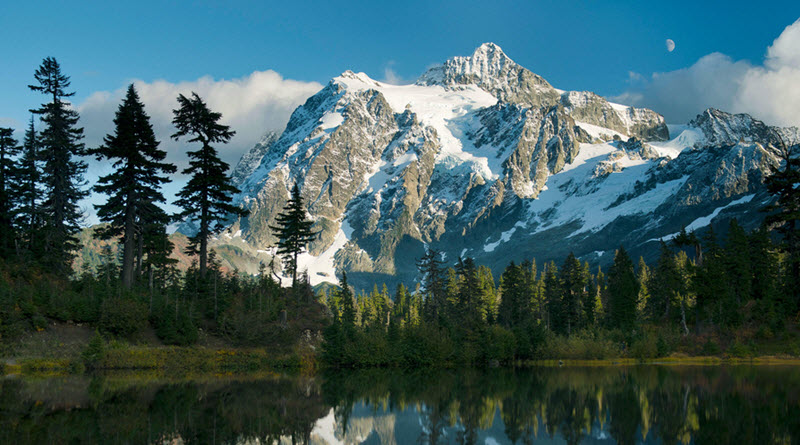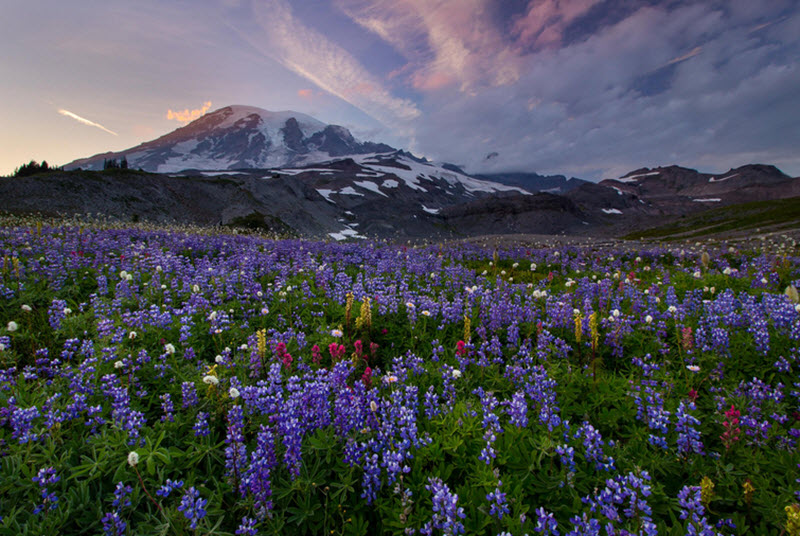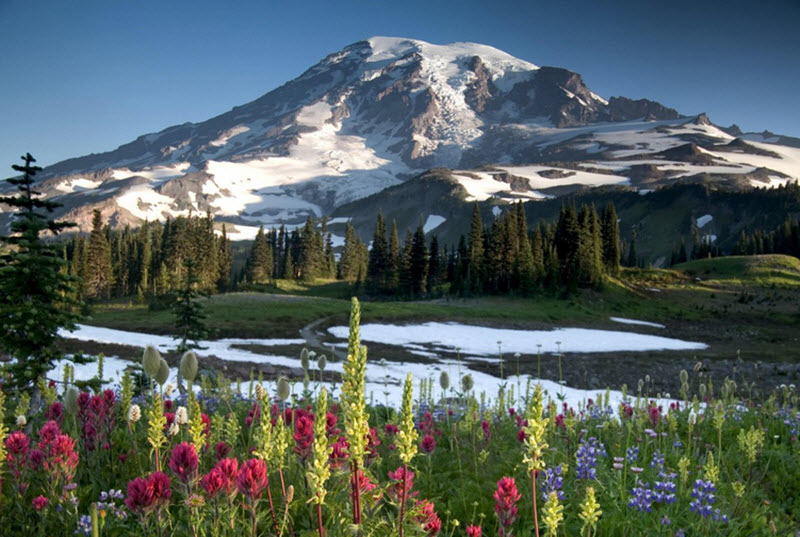
The mountains of Washington are loved by locals and visitors alike, who go there to enjoy activities such as hiking, camping, skiing, snowboarding, snowshoeing, wildlife viewing and mountaineering. There are about two dozen tall peaks to chose among and many national or state parks to explore, including the Olympic National Park, the North Cascades National Park and the Mount Rainier National Park.
Forests cover more than half of Washington State’s total land area, with the lands west of the North Cascades being especially heavily forested. Roughly two-thirds of Washington’s forested area is publicly owned, including federal lands.
Examples of mammals native to the Washington wilderness are gray wolf, black bear, cougar, bobcat, moose, elk, deer, mountain beaver, river otter, pocket gopher, and muskrat.
Camping, hiking and mountaineering in the North Cascades National Park

The North Cascades National Park is located northeast of Seattle, approximately 100 miles (160 km) from the city. Most of it is wilderness, but there are some roads and a few maintained buildings.
Examples of spots popular among mountain climbers are Mount Triumph, Eldorado Peak and the Picket Ranges.
Camping
There are no campgrounds within the park that are connected by road. Camping within the park is permitted, but only if you have a permit. The Wilderness Information Center located near Marblemount can help you with more information about permits.
Hiking
There are roughly 400 miles of hiking trails within the park, including two National Scenic Trails: The Pacific Crest Trail and The Pacific Northwest Trail.
Biking
Bicycles are allowed in the park, but only on the roads that also allow motorized vehicles.
Biking on hiking trails is not permitted.
Mountain climbing
It is not hard to understand why this park is such a favorite among mountain climbers. Here, you can explore many different cliffs and rocks, go bouldering, engage in ice climbing and much more. Some peaks and cliffs are fairly easy to access, while others require a multi-day trip.
Please note that installing fixed point anchors in the park is no longer allowed. Only removable anchors, such as chocks and cams, may be used.
Visiting the Cascade Pass
This is an important pass that connects the Cascade River with the head of Lake Chelan, and it was used extensively by the Native Americans in the area who traded goods between the coast and the inland. Once you have reached the summit of the pass, you will have an amazing view of your surroundings in all directions.
There is no road to or through the pass; but hiking trails are available. If you come from the west, a 3.5 mile trail will take you from the end of the Cascade River Road to the pass. From the east, you can hike the trail from Stehekin up the Stehekin River Valley.
For mountaineers, the pass serves as an entry to various summits in the area, such as the Sahale Mountain, Mixup Peak, Magic Mountain and Cache Col.
Exploring the Mount Rainier National Park

This National Park, which was established back in 1899, is located in Pierce County and Lewis County. It is the fifth oldest national park in the country, and derives its name from the stratovolcano Mount Rainier which rises sharply from the surrounding land.
This park includes over 40 spots listed in the National Register of Historic Places, including four National Historic Landmarks.
Hiking
Mount Rainier is circled by the Wonderland Trail, a 90+ mile hiking trail built in 1915. This trail goes over many ridges and sports a cumulative 22,000 feet elevation gain. Hiking the entire trail usually take two weeks, a feat accomplished by 200-250 people annually. Hiking just a part of the trail is much more common, with several thousands of hikers doing so each year.
Mountain climbing
In an average year, approximately 10,000 attempts to reach the summit of Mount Rainier are made. The success rate is estimated to be around 50%.
Paradise
Paradise is one of the most popular destinations for park visitors. This is where the historic Paradise Inn was built in 1916. Today, Paradise also has a visitor center.
Coordinates: 46.79°N 121.74°W
Elevation: 5,400 feet / 1,600 meters
Longmire
Longmire is a visitor center located in the Nisqually River valley, 6.5 miles east of the Nisqually entrance. It’s a very beautiful area, flanked by the Ramparts Ridge and Tatoosh Range, and with old-growth trees of species such as Douglas fir and Western hemlock.
At Longmire, you can visit the Longmire Museum and the Wilderness Information Center. There is also the National Park Inn, the only lodging in the park that is open year round. If you prefer camping, there is a campground at Cougar Rock just 2 miles north-west of Longmire, open from late May through late September.
Coordinates: 46.75°N 121.81°W
Elevation: 2,761 feet / 842 meters
Sunrise
At Sunrise, in the northeaster part of the park, you’ll find a lodge and a visitors center. This is the highest point in the park that you are allowed to drive your car to. Near the White River entrance, turn off from SR 410 and drive approximately 10 miles to reach the lodge.
Many hiking trails can be accesses here, including the Sourdough Ridge and Mount Fremont trails.
Coordinates: 46.91°N 121.64°W
Elevation: 6,400 feet / 1,950 meters
Visiting the Olympic National Park

The Olympic National Park is located on the Olympic Peninsula in Western Washington. It was designated a National Park in 1938, an UNSESCO International Biosphere Reserve in 1976 and a World Heritage Site in 1981.
The four main nature types in the park are:
- Coastal nature
- Alpine areas
- The temperate rainforest in the west
- The dryer but still forested east side
Hiking
Several roads go into the park, but they don’t penetrate deep. If you want to reach the remote wilderness, there is an extensive network of hiking trails.
From Hurricane Ridge, there is a paved 1.6 miles long one-way paved trail with an elevation gain of roughly 700 ft. From this paved trail, several unpaved trails branch off. Please note that snow sometimes linger on the trails as late in the year as July.
Rafting
Rafting takes place on both the Elwha River and the Hoh River.
Boating
Boating is common on the lakes Crescent, Ozette and Quinault.
The beach
The park include a very long beach area that many visitors devote several days to explore. It’s important to remember that this is a tidal area, and there are passages that gets blocked during hide tide. The beach is dotted with promontories that can be quite challenging to get over.
Hurricane Ridge
Hurricane Ridge is a beautiful not-for-profit winter sport area, operated by a sports club that maintains the slopes for skiing and snowboarding. Skiing lessons, equipment rental and reasonably priced lifts are available.
The Hurricane Ridge is visited outside the skiing season as well, since there is a viewpoint here with picnic areas, visitor center and trail heads. The picnic area and the adjoining restrooms are only open in the summer season.